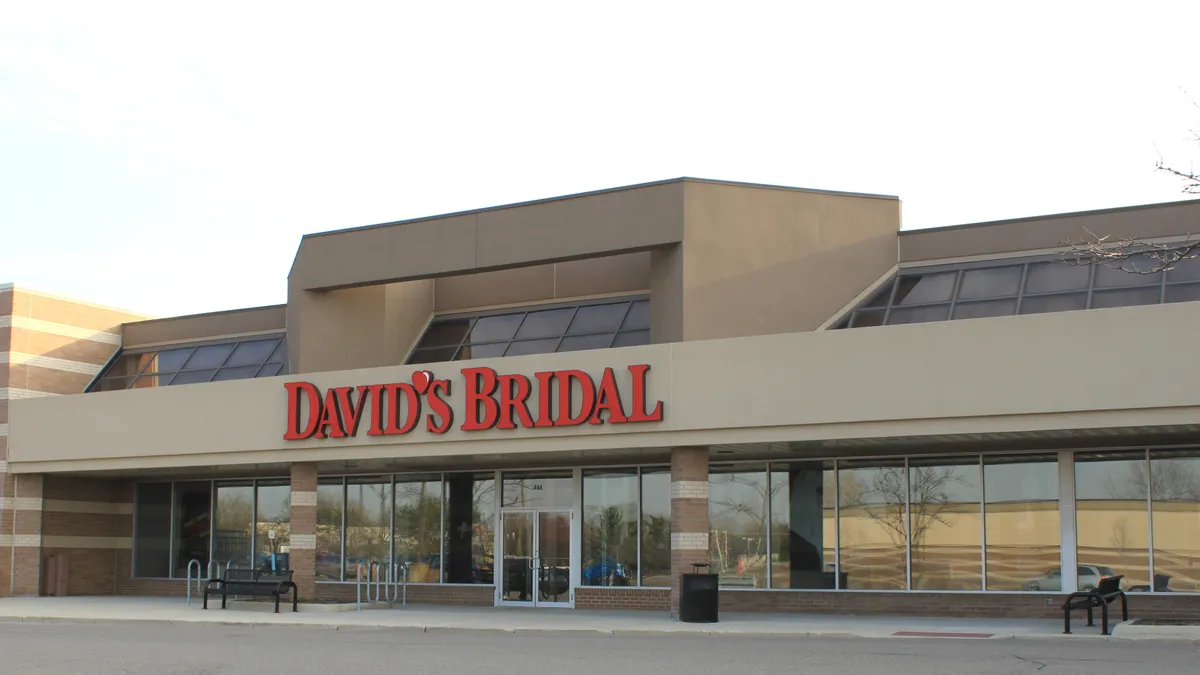UPDATE: November 5, 2019: David's Bridal has received "firm commitments" for $55 million in new capital from its lenders to fund growth investments, according to a press release. The wedding apparel retailer also forged an agreement to trade $276 million on its term loan principal into new stock in the company.
The agreement had unanimous support from David's Bridal lenders and leaves the company with total funded debt of $75 million and a revolving credit facility of $125 million. Jim Marcum, David's Bridal CEO, said in the release that the debt deal provides the retailer with resources and flexibility "to focus on changing the David's Bridal experience by modernizing our branding and marketing, investing in tools and platforms to support brides during the entire wedding planning process, and enhancing the customer experience in-stores and online."
Dive Brief:
- Less than a year after emerging from bankruptcy, David's Bridal is preparing for talks with lenders in search of a solution to its ailing balance sheet, according to reporting from Debtwire.
- The wedding apparel retailer hired investment bank Greenhill & Co. "for help pursuing balance sheet solutions such as a consensual deal with lenders," according to a Debtwire report emailed to Retail Dive. David's Bridal did not provide comment to Retail Dive by press time.
- In September, the company postponed its second quarter financials (which are disclosed privately to investors), prompting a market selloff of its debt. Some lenders are also preparing for talks around removing debt from David's Bridal's balance sheet, Debtwire reported earlier.
Dive Insight:
David's Bridal went into Chapter 11 a little over year ago, using the court process efficiently to turn over ownership to its lenders and remove debt from its books.
It exited bankruptcy less than two months later with $450 million in debt knocked off its books and new plans to lower prices on best-sellers, expand sizing, offer a broader online assortment in bridesmaids and special occasion dresses, and add more in-store events.
But specialty retail's structural struggles persist, as do David's Bridal's debt servicing demands. S&P Global downgraded the retailer's credit rating into junk territory in May. The ratings firm said then that the retailer's performance "remained significantly weaker than anticipated after emergence from bankruptcy."
With poor customer traffic weighing on David's Bridal, analysts with S&P raised questions about its ability to repay its debt, adding that its post-bankruptcy debt load might be "potentially unsustainable based on its rapidly weakening operating performance, which makes it vulnerable to unfavorable business and financial conditions to meet its commitments in the long term."
The company told Retail Dive at the time that under new management it was "executing a strategic transformation and strengthening its financial foundation to return the Company to its position as the clear leader in the bridal industry."
The past year has offered a stark reminder about how difficult it is for indebted retailers to overcome vast changes across retail. This year has seen numerous Chapter 22 trips to bankruptcy — namely Payless, Gymboree, A'gaci and Charming Charlie. Those retailers had managed to reduce debt in prior court cases and tried to engineer turnarounds in slimmed-down form. But their challenges proved too numerous, their post-bankruptcy debt loads still too high, and they liquidated in their second Chapter 11.
David's Bridal's struggles are exacerbated by a category in upheaval. Causing pain for wedding dress sellers are casualization, fragmentation and a decline in weddings. Gap Inc. abandoned a bridal startup it had acquired, J. Crew shut down its bridal store in 2016, and bridal retailer Alfred Angelo abruptly shuttered roughly a year and a half before David's Bridal filed for Chapter 11.













